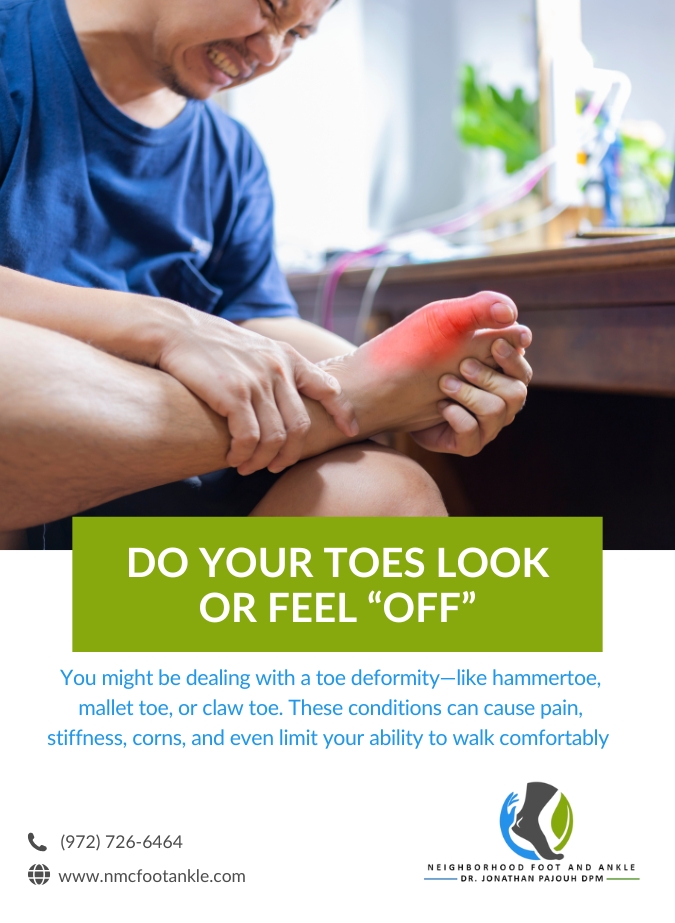
Do Your Toes Look or Feel “Off”? Recognizing and Treating Toe Deformities
Did you know that toe deformities like hammertoe, mallet toe, and claw toe can affect your daily life more than you realize? Many people suffer from these conditions, often experiencing pain, stiffness, and even difficulty walking comfortably. Understanding these issues and pursuing the right treatment options is essential. In this comprehensive guide, we’ll discuss the types of toe deformities, their symptoms, potential causes, and effective treatment strategies—which range from conservative care to surgical solutions. By the end of this post, you’ll gain valuable insights to help you care for your feet and possibly find relief from your discomfort.
What Are Toe Deformities?
Toe deformities refer to conditions that alter the normal structure and alignment of the toe. The most common types include hammertoe, mallet toe, and claw toe. Each of these conditions presents unique characteristics, and understanding them is critical for seeking appropriate treatment.
- Hammertoe: This condition results in a bend in the middle joint of a toe, causing it to resemble a hammer. The toe may be able to move but is often rigid and uncomfortable, pressing against your shoe.
- Mallet Toe: In this variant, the joint closest to the tip of the toe is bent downwards. It can occur in conjunction with hammertoe and lead to pain and discomfort in the shoe.
- Claw Toe: This deformity involves an upward bend at the joint near the ball of the foot and a downward bend at the middle and end joints, leading to a claw-like appearance.
Understanding the Symptoms
People with toe deformities may experience a range of symptoms that can significantly affect their daily activities. Common symptoms include:
- Pain or discomfort in the affected toe
- Stiffness in the toe joints
- Development of corns or calluses due to friction from footwear
- Difficulty finding comfortable shoes that properly fit their feet
- Swelling or redness around the affected joints
Potential Causes
Multiple factors can contribute to the development of toe deformities. Recognizing these causes can assist in prevention and treatment options:
- Genetics: Family history can play a significant role in the likelihood of developing toe deformities.
- Footwear: Bad shoe choices, such as high heels or tight-fitting shoes, can exacerbate or cause these conditions.
- Injury or Trauma: Past injuries to the toes can trigger deformities later on.
- Health Conditions: Conditions like arthritis, diabetes, or nerve damage might increase the risk of developing toe deformities.
Treatment Options for Toe Deformities
If you suspect that you have a toe deformity, it’s important to consult with a healthcare professional for a proper diagnosis and treatment plan. Options may include:
Conservative Treatments
1. Footwear Modifications: Switching to shoes that accommodate your foot’s shape, such as wider toe boxes, can alleviate pressure and pain.
2. Orthotics: Custom orthotic devices can help realign the position of the foot and relieve additional stress.
3. Stretching and Strengthening Exercises: Gentle exercises can help maintain joint mobility, relieve stiffness, and strengthen the muscles around the toes.
4. Physical Therapy: A physical therapist can provide personalized exercises to improve strength and mobility, reducing discomfort.
5. Over-the-Counter Pain Relief: Nonsteroidal anti-inflammatory drugs (NSAIDs) can be effective for managing pain and inflammation.
Surgical Treatments
When conservative treatments fail to provide adequate relief, surgical intervention may become necessary. Common surgical procedures can include:
- Tendon Release: This surgery may be performed to correct the muscle imbalance causing the deformity.
- Joint Resection: In some cases, removing part of the affected joint may be required to relieve pain and restore function.
- Screw or Pin Insertion: Surgeons might use screws or pins to stabilize the toe in the proper position post-surgery.
The Importance of Seeking Care
For some individuals, living with a toe deformity might seem manageable. However, neglecting proper treatment can lead to worsening pain and significant mobility issues in the future. Ignoring these symptoms may even result in additional complications, including the risk of developing ulcers in diabetic patients or increased pressure on other joints.
Taking Action
If you’re experiencing signs of toe deformities, don’t wait for the discomfort to escalate. It’s crucial to seek the guidance of a qualified professional to evaluate your condition. Dr. Jonathan Pajouh is skilled in providing personalized assessments that can guide you toward the right treatment plan—whether that involves conservative care or surgical options tailored to your unique situation.
Conclusion
Now that you’ve gathered valuable insights about recognizing and treating toe deformities, it’s time to take action. If you or someone you know is dealing with foot pain or feels their toes look “off,” consider reaching out for an evaluation. Early intervention can make all the difference in preventing further complications and restoring your quality of life.
Book Your Appointment with Dr. Pajouh to discover the best options for you. Contact Us – Reconstructive Podiatric Foot & Ankle Surgeon, Dallas TX
